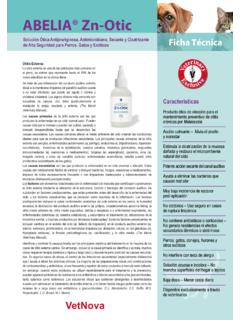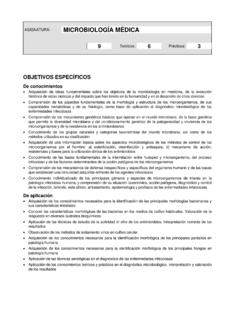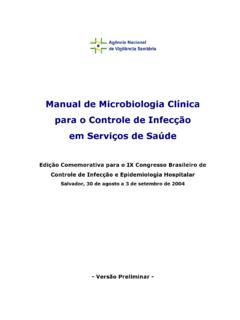Transcription of Staphylococcus, Malassezia, and Pseudomonas: …
1 Keith A. Hnilica DVM, MS, Dip. , malassezia , and pseudomonas : Why are they there and what to do about skin s normal structure and function serve as a very effective defense against infectiousagents. Normal skin is designed to keep normal flora in control and prevent of the SkinBarrier(1)Physical (Keeps the good stuff in and the bad out). of water, electrolyte & macromolecule of invasion by external agents: chemical,physical, microbial organisms(2)Physiologic (designed to kill or avoid organisms) rate - the routine turnover rate is 21 to 30 days for akeratinocyte to progress from basal layer to the surface.
2 Injuriescause an increased mitotic rate resulting in a shorter time forkeratinocytes to reach the surface. The skin continuously sloughs tohelp get rid of nasty and fatty acids are bacteriostatic and salts are antimicrobial(3)Immunologic - The skin is the largest immunological surveylence 's cells (antigen presenting cells) in the , neutrophils, in sweat(4)Bacterial - the normal bacterial flora produces products that inhibit thegrowth of pathogensTemperature Regulation(1)hair coat(2)cutaneous vasculature(3)subcutaneous fat(4)sweat (species specific) - apocrine & cats - eccrine sweat in footpads onlySecretion(1)
3 Apocrine glands - pheromones(2)sebaceous glands - antimicrobial(3)epidermal lipids - wax sealKeith A. Hnilica DVM, MS, Dip. the skin is affected by almost any primary disease (allergies, endocrinopathies,parasites, autoimmune skin disease, etc) the normal structure and function of the skin is changes cause the effective antimicrobial defenses (salts, acidity, turnover, temperature,dehydration, etc) to become dysfunctional. The result is increased colonization, invasion, andsecondary infections are secondary to the primary/underlying disease. Obviously, aggressiveantimicrobial therapies must be used to resolve the infection.
4 However, until the primary skindisease is identified and controlled, the infections will continue to recur due to the changes in theskin that occur with skin disease the predispose to secondary skin with dermatitisEpidermis - Saran wrapTransformed into permeable paperDehydratedIncreased moisture allows organism adherenceand penetration Turnover every 21 daysTurnover rate is changed to prevent normalmaturation and exfoliation of cellsEssential fatty acids andwaxes: antimicrobialComposition is altered decreasing theantimicrobial functionalityLangerhans cells: searchfor antigens initiating adefense immune responseLangerhans cellswill preferentially stimulate anallergic response which is ineffective againstorganismsDermisVessels cool the skinVasodilatation increases skin temperature - warmGlandsSebum: antimicrobialIncreased and altered composition is lessantimicrobial and provided nutrients for yeastSweat.
5 AntimicrobialIncreased and altered composition increase skinmoistureAcidityIncreases in pH are less antimicrobialSaltsDiluted salt concentrations decrease theantimicrobial effectIgADecreases in IgA and switched to IgG secretiondecrease antimicrobial effectGeneralPruritus damages the skin and spreads organismsfrom the mouth to the A. Hnilica DVM, MS, Dip. PyodermaPyoderma (bacterial folliculitis) is the most common skin disease in dogs. Secondary pyoderma isa complicating factor in most dermatologic conditions. Approximately 80 percent of allergic dogswill have an active secondary pyoderma at the time of diagnosis.
6 The secondary infectioncomplicates the evaluation and treatment of the patient due to its ability to alter the clinicalpattern of disease and response to bacteria are Gram-positive cocci that are commonly found on the skin of mostmammals. Most of the staphylococcus organisms are innocuous inhabitants and cause fewproblems. There are several more aggressive (coagulase positive) species of Staphylococci thatare frequently associated with cutaneous disease. In dogs, staphylococcus intermediates is themost common cause of pyoderma; however, staphylococcus aureus and Staphylococcusschleiferi have been documented and are emerging as pathogenic key features make the coagulase positive Staphylococci particularly virulent pathogens.
7 These bacteria are able to produce and secrete numerous cell products that cause severe - Degrades hyaluronic of connective tissue Coagulase - Converts fibrinogen to fibrin which causes clottingKinases - Converts plasminogen to plasmin which digests fibrin Leukocidin - Disrupts neutrophil membranes and causes discharge of lysosomesStaphylokinase - Activates plasmin-like proteolytic activity that dissolves clots Streptolysin - Repels phagocytes and disrupts phagocyte membrane and causesdischarge of lysosomal granules Hemolysins - Phospholipases or lecithinases that destroy cells by lysisProtein A - binds IgG in a non-functional orientation to avoid phagocytosisExfoliative toxin - Alter keratinocyte function causing blisteringExotoxins - Induce local tissue damage and inflamationToxin Shock Syndrome Toxins - Induce a severe systemic inflammatory reactionthat can be fatalSuper Antigen - Staph can cause a non-specific super immune response thatinduces systemic inflammatory changesStaphylococci are also particularly adept at avoiding the effects of antibiotics.
8 In particular,methicillin-resistant Staphylococci have emerged as a serious medical problem. TheseStaphylococci are able to develop and transfer resistance to numerous antibiotics by means ofseveral divergent mechanisms. This flexibility allows them to rapidly adapt to new therapeuticstrategies. Unique strains of staphylococcus aureus have been identified that are resistant to allknown antibiotics. Until recently, these extremely resistant Staphylococci were limited to thespecies staphylococcus aureus and remained primarily a human dilemma. Recent reports haveidentified staphylococcus aureus infections in dogs that are multidrug resistant and potentiallyzoonotic.
9 staphylococcus schleiferi has recently emerged as a common cause of caninepyoderma. staphylococcus schleiferi has the ability to develop multidrug resistance (using similar mechanisms as staphylococcus aureus) and is known to be A. Hnilica DVM, MS, Dip. :The three essential components of successful treatment of secondary bacterial pyoderma in dogsinclude the proper selection of antibiotic, treatment with appropriate dose and duration ofantibiotic therapy, and the identification and control of all underlying dermatoses (allergies,endocrinopathies, autoimmune diseases, keratinization defects).
10 Bacterial pyoderma is a commoncause of pruritus. For this reason, it is important to determine the cause of a patient s pruritus(pyoderma, yeast dermatitis, allergies) rather than treating the itch with steroids. Topical therapyis also of great benefit to help mechanically remove organisms as well as providing a nonantibioticmethod of killing the organisms. Shampoos containing chlorhexidine or benzoyl peroxide arehighly effective at reducing the superficial colonization of first time pyodermas:The overwhelming majority of first time bacterial pyodermas in dogs are caused byStaphylococcus intermedius.




